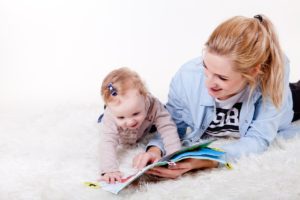Reading Strategies for Increased Speech and Language Skills
Kids Place Pediatric Speech Therapists
Reading. This word generally carries an automatic association with school and academic learning. However, many parents may not realize that in addition to academic growth, reading can also help develop a child’s speech and language skills. Here are some of the ways reading helps speech/language development:
Communication
Reading books together creates opportunities for joint attention, the shared focus of two people on an object. Joint attention is an important precursor for language development. The more your child is able to attend to you and a book, the more likely they are to engage in communication with you. Infants first show joint attention by eye gaze, then by pointing, vocalizations and eventually real words. That is why reading is beneficial even at a very young age.
Vocabulary
Reading exposes children to new vocabulary and provides meaningful contexts that help them learn what new words mean. Once a child understands the meaning of a new word, they can learn to use that word on their own. Children with language impairment need to hear a word in context about 25 times before they comprehend the word. They need an additional 25 exposures and practice saying the word before they can produce it independently.
Answering questions
Reading provides opportunities for you to ask your children questions about the story. When children practice answering questions while reading, it helps them learn to answer questions appropriately in everyday life. For example, they learn that when you ask a “where” question, the answer is a “place”.
Social Skills
As children develop, they experience more and more novel social situations. These experiences allow them to learn through practice how to interact appropriately with others and solve problems. Reading books creates opportunities to talk with your child about possible social situations they might encounter and how to handle them effectively.
Phonological Awareness
By teaching your child the relationship between letters, the sounds letters make, and the letters/sounds that make up words, you are also teaching your child the importance of saying sounds correctly so that others can understand the words they are saying. Books offer an abundance of words for your child to practice saying sounds, or simply to listen to the contrasts in sounds.
What can you do when you’re reading together to increase these skills?
You can target receptive language (understanding) by having your child point to pictures in books (e.g. “Where is the dog? Show me the dog.”), which helps them make the associations between words and meaning. You can teach them descriptive concepts, such as colors, shapes, size by modeling and then asking them to point to the appropriate picture (e.g. “here is the BIG dog. Can you find the BIG cat?”, “Which ball is red?”).
You can target expressive language (using words to communicate) by having your child imitate words from books (e.g. “Here’s the pig. Now you say ‘pig’.”). You can use “completion prompts”, where you have the child complete the sentence of a familiar book you have read many times (e.g. “Chicka chicka boom boom will there be enough __?”). Ask them “wh” questions (who, what, where, when, why, how) about the story, such as “Where did the boy go?” Have your child predict what’s going to happen next before you turn the page, or challenge their recall skills by asking what happens next with a book they’ve read before. Reading the same books several times is helpful for children’s learning, as they are given more opportunities to understand concepts and make new connections. Having your child retell the story to you is another way to get them talking.
Discussing the events, characters, and characters’ feelings in stories can help children develop social skills. Ask your child questions about how a character feels and get them to relate the character’s experience to their own experiences. For example, “The little red hen invited people to help her. Can you think of a time you invited someone to help you? How did you feel if they didn’t help?”. Asking questions about how a character could’ve acted differently develops your child’s problem-solving skills needed to think through a situation and come up with possible solutions.
If your child has a speech or “articulation” delay, you can have them practice saying some of the words in the book that have their “target sounds”, or the sounds that they have trouble producing. Even just bringing their attention to their target sounds is helpful for them to increase their awareness of these sounds in their own speech. For example, “Oh look, the boy got out the soap to take a bath. ‘Soap’…that has our “s” sound in it. Let’s practice, ‘soap’. Now you say it.” You can even find books that are loaded with a certain sound, so that there are many opportunities for the child to practice their target sounds.
If you are overwhelmed with the selection of books available, and choosing the “right” ones, don’t worry. It’s not about which books you choose. Just keep reading (and re-reading!) and challenging your child. Most importantly, make it a fun experience!
Some information/examples taken from:
Quality Preschools: Classroom Environments Dialogic Reading And Working on a Preschool Team. (n.d.). Lecture presented at Arizona State University, Tempe, AZ.








